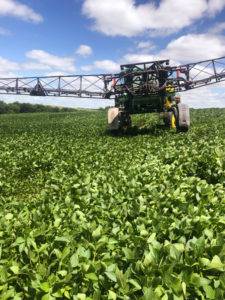 Based on a recent needs assessment poll conducted by Latham Hi‑Tech Seeds, the top two soybean trait technologies for 2022 planting will be Enlist E3® and XtendFlex® soybeans.
Based on a recent needs assessment poll conducted by Latham Hi‑Tech Seeds, the top two soybean trait technologies for 2022 planting will be Enlist E3® and XtendFlex® soybeans.
Both technologies have triple-stacked traits, featuring tolerance to glyphosate (Roundup) and glufosinate (Liberty®) herbicides. Enlist E3 soybeans also are resistant to 2,4-D Choline herbicides (Enlist Duo® & Enlist One®). For XtendFlex® soybeans, the 3rd tolerance is to dicamba herbicides like XtendiMax®, Engenia® and Tavium®.
Do everything you can now to keep resistant weeds from gaining a foothold in your fields. Following are five key takeaways for effectively using weed control programs with both trait packages:
- Start with a clean field. One or two tillage passes may be necessary to take care of emerged weeds. For no-till operations, a good burndown herbicide program is needed.
- Always use a pre-emergent herbicide program whether before or after you plant. Consult your local ag chem retailer for herbicide recommendations for your area but try to use a program with multiple herbicides and sites of action.
- Use a strong (multiple site of action) post-emergent herbicide program.
For post-emergent applications in Enlist soybeans: I like what I’ve seen when Enlist One and Liberty are applied together. Pay attention to weed size, the stage of your crop, and label rates. If needed, you can use a second application of Enlist One if you wait at least 12 days and it’s before the full bloom stage (R2).
For post-emergent applications in XtendFlex soybeans: You CANNOT tank mix any dicamba-based product with Liberty! I like applying XtendiMax (plus applicable tank mix partner/s) either pre-emergence or early post-emergence and then having the flexibility to come back at or before R1 with Liberty. This maximizes the benefits from this new technology while keeping you in compliance with the EPA-approved herbicide labels. Applying XtendiMax early also decreases the chances of off-target dicamba movement to sensitive crops.
- As always, read and follow all label directions for herbicide use. Whoever applies these herbicides is directly responsible for knowing the labels, including all setback and buffer requirements.
- Knowing what is planted where is a matter of crop life and death. All forms of dicamba and 2,4-D belong to the auxin (Group 4) chemical family but react differently, depending on the herbicide trait package being used. Remember, this family primarily controls broadleaf weeds. Most grasses show little or no effect from the application of Group 4 herbicides. XtendFlex and Xtend soybeans are tolerant only to dicamba-based products and can be killed with an application of any 2,4-D product. Likewise, if you spray Enlist E3 soybeans with dicamba, they will die.
